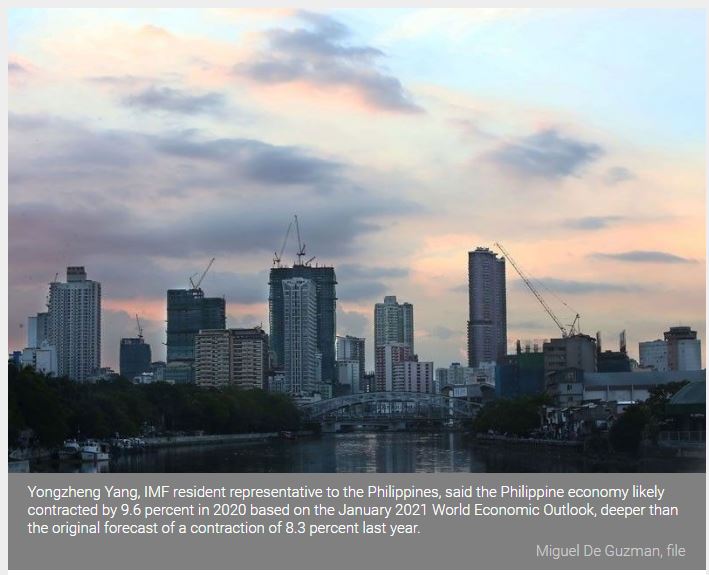Philippines: ‘Deeper decline, slower rebound’
IMF on Philippines GDP in 2020, 2021
MANILA, Philippines — The International Monetary Fund (IMF) now expects a deeper economic contraction for the Philippines as the country continues to struggle to limit the impact of the pandemic.
Yongzheng Yang, IMF resident representative to the Philippines, said the Philippine economy likely contracted by 9.6 percent in 2020 based on the January 2021 World Economic Outlook, deeper than the original forecast of a contraction of 8.3 percent last year.
“The downward revision for 2020 mainly reflects the larger-than-expectation year-on-year contraction in the third quarter” Yang said in an e-mail.
IMF’s projected GDP contraction was slightly deeper than the revised 8.5 to 9.5 percent target by the Development Budget Coordination Committee (DBCC) in December last year.
The Philippines slipped into recession with a GDP contraction of 10 percent from January to September last year as the economy stalled when Luzon was placed under enhanced community quarantine in mid- March to slow the spread of COVID-19.
The slowdown eased to 11.5 percent in the third quarter last year from a record 16.9 percent in the second quarter as the National Capital Region (NCR) shifted to general community quarantine, allowing the economy to partially reopen.
Despite imposing the longest and strictest lockdowns in the world, COVID-19 cases in the Philippines breached the 500,000 mark a few days ago with deaths of more than 10,000.
The multilateral lender, Yang said, is also looking at a slower recovery with a GDP growth of 6.6 percent this year based on the January 2021 WEO instead of the previous projection of 7.4 percent.
For 2022, IMF expects the Philippine economy to grow by 6.5 percent.
“The projected rebound in 2021 and 2022 is primarily driven by a renewed infrastructure investment push and a gradual recovery of the private sector, supported by accommodative monetary policy and global recovery,” Yang said.
The projected growth of IMF for this year is within the DBCC’s 6.5 to 7.5 percent target, while that of next year is way below the DBCC’s eight to 10 percent GDP growth target.
Yang said risks to IMF’s GDP growth forecasts for this year and next year include the rollout of COVID-19 vaccines in the country.
“The key risk to these forecasts stems from the uncertainty over how the pandemic will evolve, both globally and in the Philippines. The rollout of vaccines will help boost recovery, but progress and its impact are subject to uncertainty,” Yang said.
For the ASEAN-5 including the Philippines, the IMF is looking at a deeper contraction of 3.7 percent for 2020 and a slower recovery with a GDP growth of six percent for this year.
The multilateral lender is also looking at a smaller global GDP contraction of 3.5 percent for 2020 and a stronger rebound with a growth of 5.5 percent for this year.
“The projected growth recovery this year follows a severe collapse in 2020 that has had acute adverse impacts on women, youth, the poor, the informally employed, and those who work in contact-intensive sectors,” IMF said.
Source: https://www.philstar.com/business/2021/01/27/2073243/deeper-decline-slower-rebound


 Thailand
Thailand




